Apr 12, 2023
Ainokura’s gassho-zukuri residents share stories of the way things used to be
Gallery - Ainokura Village gassho-zukuri houses, Gokayama, Japan
In the village of Ainokura in Japan’s central Hokuriku Sanken region, residents who call the area’s traditional gassho-zukuri buildings home, are making efforts to share the message of their heritage with visitors.
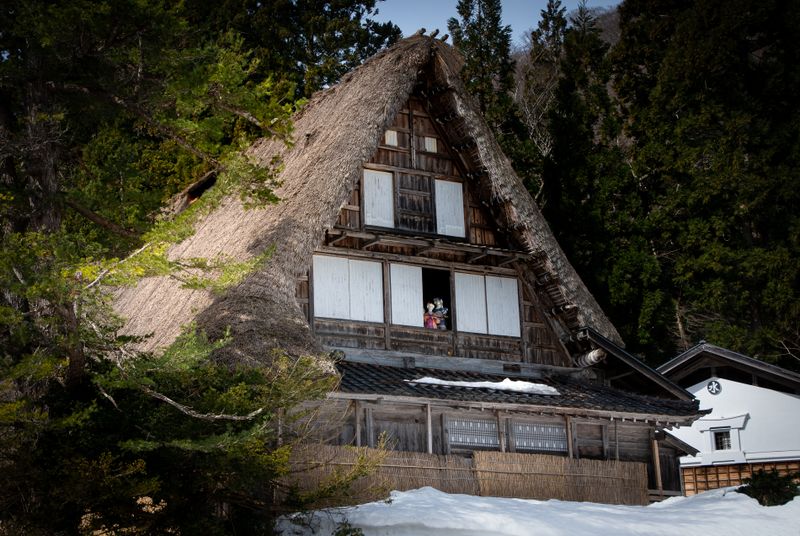
(Yusuke house, a gassho-zukuri home in the village of Ainokura, Toyama Prefecture. Photo taken March 2023.)
Tea is poured and we all relax around the warmth of the traditional irori hearth, the beating heart, even today, of this old home. This is the way things are here, and the way things used to be for the rest of us - conversation and companionship, sharing stories over a steaming beverage.
This is the gassho-zukuri home Yusuke, the largest of the traditionally constructed houses in the village of Ainokura in Japan’s mountainous Gokayama region, straddling Toyama and Gifu prefectures.
In mid-March the distinctive steeply-pitched thatched roofs - said to resemble the “gassho” gesture of hands placed together in prayer - of Ainokura’s gassho-zukuri houses are free of the winter snow which they were constructed to resist, snow which can pile up around the village to depths of two meters. With spring on the horizon what snow remains now collects at their base, covering the village’s untrodden flats and just about clinging to the mountain sides.
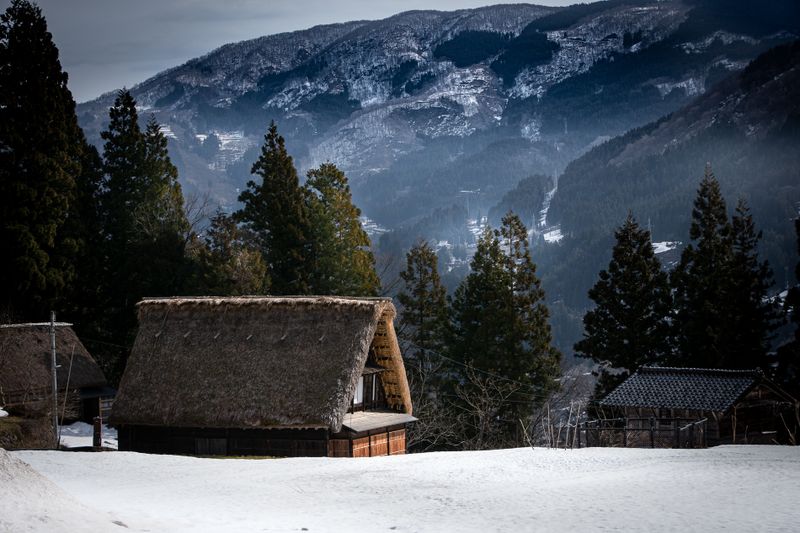
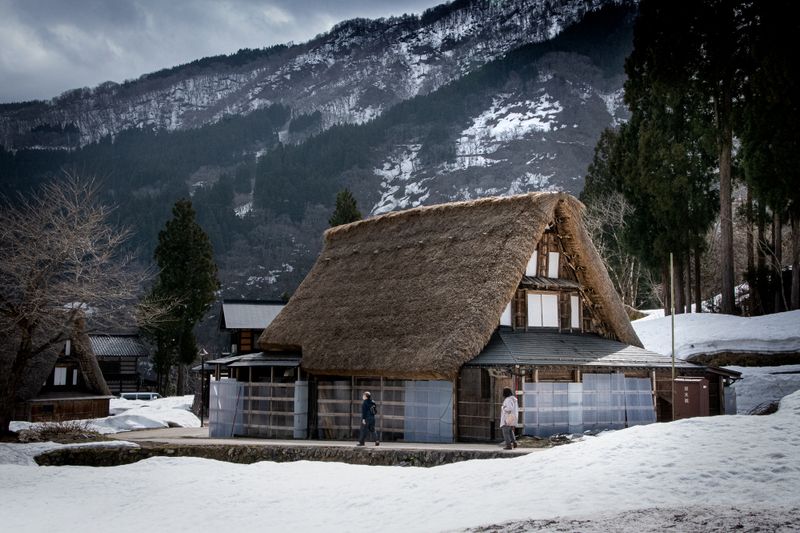
(Ainokura Village, Toyama Prefecture. Photo taken March 2023.)
Yusuke is one of the 20 gassho-zukuri houses in Ainokura. Citing the houses as rare examples of their kind in Japan the village, along with the villages of Suganuma (Toyama Prefecture) and Ogi-machi (Shirakawa-go, Gifu Prefecture), was registered by UNESCO as a World Heritage site 1995. The organization describes the villages as “outstanding examples of a traditional way of life perfectly adapted to the environment and people's social and economic circumstances.”
The traditional houses look beautiful against the mountainous landscape, and even though their style was developed out of a blunt necessity to handle the unforgiving environment, they are proof that aesthetics can result from people living in harmony with the landscape around them. In a Japan obsessed with pouring concrete and stringing up electrical wiring, the sight of Ainokura, stretching out over a distance of around 500m at its longest point, is almost surreal.
Perhaps even more surreal is that people still call this remarkable place home. Ainokura has a population of 40, some of whom live in the gassho-zukuri houses. This population, however, has more than halved in the nearly 30 years since the village was inscribed into UNESCO’S World Heritage list.
With a declining population making it increasingly difficult to maintain the village the Foundation for the Preservation of World Heritage Ainokura Gassho-Zukuri Village launched a project inviting people to live in a vacant house within the village.
Since the project began in 2012, the number of children under junior high school age has increased from three to 13, making Ainokura’s population a young one - another stark contrast with much of the rest of Japan.
One of the village residents is Hitoshi Nakashima, a local guide and interpreter. Nakashima grew up in the city of Takaoka, with a population of around 165,000 the second largest city in Toyama Prefecture, and moved to Ainokura around 10 years ago after “marrying into” the village.
“My stage name is Sangoro. First name Hitoshi, last name Nakashima, stage name Sangoro. Only in the countryside. Ancient rules,” Nakashima told us with a giggle.
Cut off from the rest of the world and with conditions not suited to traditional agriculture, the predecessors of today’s Ainokura residents developed a unique subsistence lifestyle which centered on the production of traditional washi paper and ensho, a material used in gunpowder, as well as sericulture, using the attic of the gassho-zukuri for silk cultivation.
“Gassho-zukuri houses evolved with the development of each domestic industry,” Nakashima said. “When modernization came to Japan, however, the houses gradually disappeared.”
Today rice-growing and other forms of agriculture can be practiced in Ainokura thanks to an irrigation system piping in water from the mountains, according to Nakashima.
Construction of most of Ainokura’s gassho-zukuri houses in their current guise was completed from the end of the 19th century to the early 20th century. The oldest is estimated to date back to the 17th century.
“You can see how lived in a house is, by looking at how dark the roof has become from the smoke of the irori,” said Shigeru Ikehata who, along with his wife, is the resident and owner of the Yusuke house. (“Yusuke” is their stage name. Ancient rules!)
While Yusuke also houses an exhibition space displaying information about the history and folklore of Ainokura and the Gokayama region, as well as serving as a guest house accommodating overnight visitors, for Ikehata and his wife, it remains a working home.
“My wife and I live here together. This is our home. It’s connected to our lives,” he said as tea was served by the irori hearth.
“The irori is in every single traditional Japanese home. It’s the center of our life - we make dinner here, talk around here. It’s the center of how we live.”
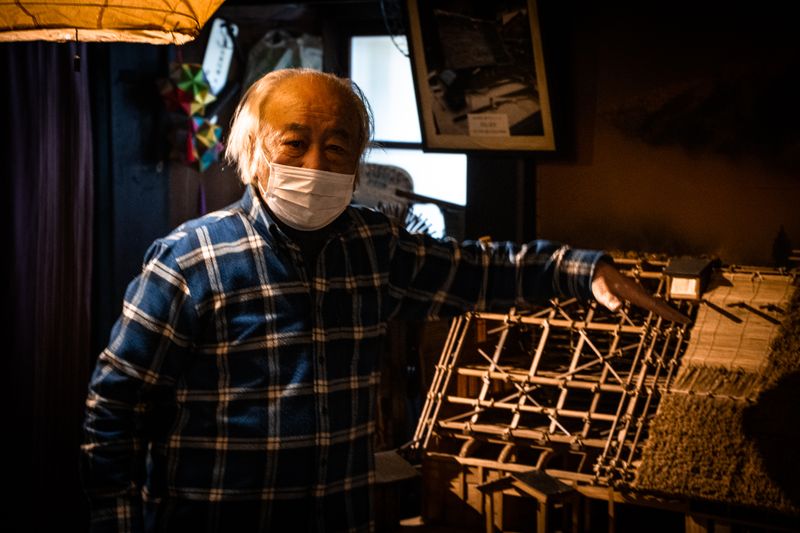
(Shigeru Ikehata in his home in Ainokura Village, Toyama Prefecture. Photo taken March 2023.)
According to Ikehata, the gassho-zukuri are built on top of pre-existing structures which date back around 2,000 years. (Earthenware excavated in the Gokayama region is thought to date back to the middle of the Jomon Period (14,000 - 300 BCE).)
“People began adding upper floors to the houses around 400 years ago, so the lower floors of the homes and the upper floors were built by totally different people,” Ikehata said.
The lower floors of the gassho-zukuri were typically used as living space while the upper floors were used for manufacturing and production.
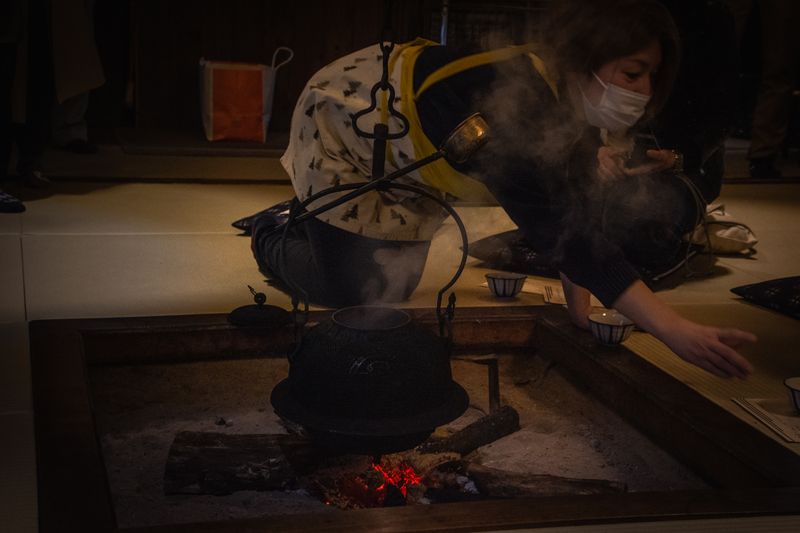
(Irori hearth at Yusuke, the center of life in the gassho-zukuri, Ainokura Village, Toyama Prefecture. Photo taken March 2023.)
Visitors to Yusuke can navigate a steep staircase leading to the attic floor to see items and displays relating to sericulture, including silkworm shelves from which the sound of larvae chomping down on mulberry leaves could once be heard in the house.
Back down by the irori, we were serenaded by a performance of kokuriko, a Gokayama folk song and dance said to be the oldest of its kind in Japan, dating back around 1,400 years. The performance came courtesy of a member of the Gokayama Folk Song Preservation Society, replete in warrior hunting costume and ayai hat, and brandishing a sasara wooden percussion instrument which with a strong flick of the wrists sent a piercing hissing sound flying around the room.
Ikehata also uses space in the Yusuke house to share the story of life in Ainokura through his photography.
Scenes in black and white, many from photographs taken during the 1960s and 1970s, tell the story of a community coming together for wedding celebrations and the repairing of roofs, of children flying kites and skiing before there were any resorts.
Other photographs show delivery men laboring through the winter snow to bring mail and parcels to the village on foot, a practice which continued until as recently as 1965, according to Ikehata.
“When the village became a World Heritage site in the 1990s people here weren't sure how to move forward. We thought about making guesthouses and shops out of the gassho-zukuri. Most important to us though, was the question of how we should share our heritage with visitors,” Ikehata said.
Pointing to the apex of the roof, Ikehata drew our attention to the beams made from the 400-year-old trees which grow on the mountain sides that help to make the home resistant to earthquakes.
“Nowadays we live with smartphones and laptops but here we have nature and history. We think it’s important for us to tell others about our history and our past through the things that still remain here,” he said.
“Of course, things like science and technology are important, but if we don’t we don’t pay close attention to the historical things, this would be a mistake.”
Ikehata’s words issue a cautionary note. As the rest of the world dives head first into a digital depression the residents, past and present, of Ainokura have a story that not only needs to be told, but to be heard.
Of the bus loads of visitors that will pour into the village of Ainokura each day as the snows thaw - in March already seven times more than the same time last year and surpassing pre-pandemic numbers - how many of those will listen?
Related
JAPAN’s next TOP TRAVEL DESTINATION? Traveling through Fukui & the Hokuriku Sanken



3 Comments
Terrilyn
on Apr 12
I have already fallen in love with place ❤️ I hope to visit soon.
City-Cost
on Apr 13
@Terrilyn - Thanks for the comment! Yes, it's a really nice spot. Hope you get chance to visit.
Terrilyn
on Apr 13
@City-Cost definitely will. Just started to plan